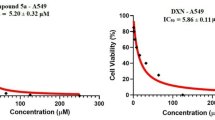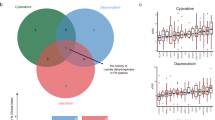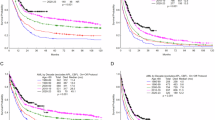Abstract
Treatment failure in AML is often attributed to P-glycoprotein-associated multidrug resistance. However, the importance of increased DNA repair in resistant cells is becoming more apparent. In order to investigate the ability of the DNA repair inhibitor aphidicolin to modulate drug resistance, we continually exposed blasts cells, isolated from 22 patients with AML, to a variety of agents ± 15 μM aphidicolin for 48 hours. Cell survival was measured using the MTT assay. Overall, there was no significant effect of aphidicolin on sensitivity to daunorubicin, doxorubicin, etoposide or fludarabine. However, there was a marked increase in sensitivity to ara-C with a median 4.75-fold increase overall (range 0.8–80-fold; P< 0.005). The effect of aphidicolin was significantly greater in blast cells found resistant in vitro to ara-C (8.9-fold compared to 2.12-fold, P< 0.01). This observation was further validated by the correlation between ara-C LC50 and extent of modulation effect (P< 0.05). Cells isolated from 10 cord blood samples were also tested in order to establish the haematological toxicity of combining ara-C and aphidicolin. The therapeutic index (LC50 normal cells/tumour cells) for ara-C + aphidicolin was higher than that for ara-C alone suggesting no increased myelotoxicity for the combination. Increased cytotoxicity without increased haematotoxicity makes the combination of ara-C plus aphidicolin ideal for inclusion in future clinical trials. © 2001 Cancer Research Campaign
Similar content being viewed by others
Article PDF
Change history
16 November 2011
This paper was modified 12 months after initial publication to switch to Creative Commons licence terms, as noted at publication
References
Åström M, Bodin L, Nilsson I and Tidefelt U (2000) Treatment, long-term outcome and prognostic variables in 214 unselected AML patients in Sweden. Br J Cancer 82: 1387–1392, doi: 10.1054/bjoc.1999.1123
Barnett D, Janossy G, Lubenko A, Matutes E, Newland A and Reilly JT (1999) Guideline for the flow cytometric enumeration of CD34+haematopoietic stem cells. Clin Lab Haem 21: 301–308
Barret J-M and Hill BT (1998) DNA repair mechanisms associated with cellular resistance to antitumor drugs: potential novel targets. Anti-cancer Drugs 9: 105–123
Braess J, Wegendt C, Feuring-Buske M, Riggert J, Kern W, Hiddeman W and Schleyer E (1999) Leukaemic blasts differ from normal bone marrow mononuclear cells and CD34+haemopoietic stem cells in their metabolism of cytosine arabinoside. Br J Haematol 105: 388–393
Bramson J and Panasci L (1995) Potentiation of chlorambucil toxicity in B-CLL lymphocytes using the DNA synthesis inhibitors aphidicolin and 1-β- D -arabinofuranosylcytosine. Biochem Pharmacol 50: 131–135
Covelli A (1999) Modulation of multidrug resistance (MDR) in hematological malignancies. Ann Oncol 10: 53–59
Elgie AW, Sargent JM, Alton P, Peters GJ, Noordhuis P, Williamson CJ and Taylor CG (1998) Modulation of resistance to ara-C by bryostatin in fresh blast cells from patients with AML. Leuk Res 22: 373–378
Freund A, Boos J, Harkin S, Schultze-Mosgau M, Veerman G, Peters GJ and Gescher A (1998) Augmentation of 1-β- D -Arabinofuranosylcytosine (Ara-C) cytotoxicity in leukaemia cells by co-administration with antisignalling drugs. Eur J Cancer 34: 895–901
Ghielmini M, Bosshard G, Capolongo L, Geroni MC, Pesenti E, Torri V, D’lncalci M, Cavalli F and Sessa C (1997) Estimation of the haematological toxicity of minor groove alkylators using tests on human cord blood cells. Br J Cancer 75: 878–883
Heim MM, Eberhardt W, Seeber S and Muller MR (2000) Differential modulation of chemosensitivity to alkylating agents and platinum compounds by DNA repair modulators in human lung cancer cell lines. J Cancer Res Clin Oncol 126: 198–204
Klumper E, Ossenkoppele GJ, Pieters R, Huismans DR, Loonen AH, Rottier A, Westra G and Veerman AJP (1996) In vitro resistance to cytosine arabinoside, not to daunorubicin, is associated with the risk of relapse in de novo acute myeloid leukaemia. Br J Haematol 93: 903–910
Kuwakado K, Kubota M, Hirota H, Adachi S, Matsubara K, Kasai Y, Akiyama Y and Mikawa H (1993) Aphidicolin potentiates apoptosis induced by arabinosy9 nucleosides in human myeloid leukemia cell lines. Biochem Pharmacol 46: 1909–1916
Kuwakado K, Kubota M, Bessho R, Kataoka A, Usami I, Wei Lin Y, Okuda A and Wakazono Y (1995) Augmentation by aphidicolin of 1-β- D -arabinofuranosylcytosine-induced c- jun and NF-κB activation in a human myeloid leukemia cell line: correlation with apoptosis. Leuk Res 19: 645–650
Longley MJ, Pierce AJ and Modrich P (1997) DNA polymerase δ is required for human mismatch repair. in vitro. J Biol Chem 272: 10917–10921
McKenna SL and Padua RA (1997) Multidrug resistance in leukaemia. Br J Haematol 96: 659–674
Mirzayans R, Enns L, Cubitt S, Karimian K, Radatus B and Paterson MC (1994) Effect of DNA polymerases inhibitors on repair of γ ray-induced DNA damage in proliferating (intact versus permeable) human fibroblasts: evidence for differences in the modes of action of aphidicolin and 1-β- D -arabinofuranosylcytosine. Biochim Biophys Acta 1227: 92–100
Moreland NJ, Illand M, Kim YT, Paul J and Brown R (1999) Modulation of drug resistance mediated by loss of mismatch repair by the DNA polymerase inhibitor aphidicolin. Cancer Res 59: 2102–2106
Plunkett W and Ghandi V (1993) Cellular pharmacodynamics of anticancer drugs. Sem Oncol 20: 50–63
Sargent JM and Taylor CG (1989) Appraisal of the MTT assay as a rapid test of chemosensitivity in acute myeloid leukaemia. Br J Cancer 60: 206–210
Sargent JM, Elgie AW, Williamson CJ and Taylor CG (1996) Aphidicolin markedly increases the platinum sensitivity of cells from primary ovarian tumours. Br J Cancer 74: 1730–1733
Sargent J, Elgie A, Williamson C and Taylor C (1997) The use of the MTT assay to study drug resistance in acute myeloid leukaemia. Adv Blood Dis 3: 33–41
Sargent JM, Elgie AW, Williamson CJ and Taylor CG (1999) Aphidicolin markedly increases the in vitro sensitivity to ara-C of blast cells from patients with AML. Adv Exp Med Biol 457: 567–570
Sessa C, Zucchetti M, Davoli E, Califano R, Cavalli F, Fristaci S, Gumbrell L, Sulkes A, Winograd B and D’Incalci M (1991) Phase I and clinical evaluation of aphidicolin glycinate. J Natl Cancer Inst 83: 1160–1164
Sherwood SW and Schimke RT (1995) Cell cycle analysis of apoptosis using flow cytometry. Methods Cell Biol 46: 77–97
Von Hoff DD (1998) There are no bad anticancer agents, only bad clinical trial designs – Twenty-first Richard and Hilda Rosenthal Foundation Award Lecture. Clin Cancer Res 4: 1079–1086
Wood RD (1996) DNA repair in eukaryotes. Annu Rev Biochem 65: 135–167
Author information
Authors and Affiliations
Rights and permissions
From twelve months after its original publication, this work is licensed under the Creative Commons Attribution-NonCommercial-Share Alike 3.0 Unported License. To view a copy of this license, visit http://creativecommons.org/licenses/by-nc-sa/3.0/
About this article
Cite this article
Sargent, J., Elgie, A., Williamson, C. et al. Circumvention of ara-C resistance by aphidicolin in blast cells from patients with AML. Br J Cancer 84, 680–685 (2001). https://doi.org/10.1054/bjoc.2000.1639
Received:
Revised:
Accepted:
Published:
Issue date:
DOI: https://doi.org/10.1054/bjoc.2000.1639



